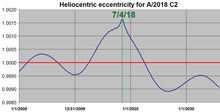 Annual motion through the Solar System | |
| Discovery [1][2] | |
|---|---|
| Discovered by | Mount Lemmon Srvy. |
| Discovery site | Mount Lemmon Obs. |
| Discovery date | 5 February 2018 (first observed only) |
| Designations | |
| C/2018 C2 (Lemmon) | |
| ZC82561, A/2018 C2 | |
| hyperbolic comet [3] | |
| Orbital characteristics [3] | |
| Epoch 20 May 2018 (JD 2458258.5) | |
| Observation arc | 272 days |
| Perihelion | 1.9565 AU |
| −1083±3 AU[a] | |
| Eccentricity | 1.0018 0.99924 (Barycentric epoch 2200)[4] |
| ≈ 130,000 years (outbound)[4] | |
| -0.00036 | |
| 0° 0m 0.072s / day | |
| Inclination | 34.453° |
| 91.14° | |
| 134.14° | |
| Earth MOID | 1.062 AU |
| Jupiter MOID | 1.405 AU |
| Physical characteristics | |
| Dimensions | 1.7–7.6 km (assumed) |
| 19.0 (March 2018) | |
| 15.1±0.63 | |
C/2018 C2 (Lemmon) is a hyperbolic comet (previously classified as A/2018 C2, a hyperbolic asteroid). It was first observed on 5 February 2018 by the Mount Lemmon Survey conducted at the Mount Lemmon Observatory near Tucson, Arizona, in the United States.[1] The discovery was announced on 4 March 2018 along with another hyperbolic object, A/2017 U7.[2] Based on the absolute magnitude of 15.1, it may measure several kilometers in diameter.[5] On 22 March 2018 it was determined to be a hyperbolic comet.[6]
YouTube Encyclopedic
-
1/5Views:5 812 60454115 8624 3751 541
-
Lemon Water at Calamansi : Sino Pwede at Sino Bawal ? Payo ni Doc Willie Ong #577
-
Edexcel GCSE Mathematics Paper 1H May 2018 (Potential Paper)
-
Lecture on DISH: diffuse idiopathic skeletal hyperstosis of the spine
-
Every AQA A Level Physics Required Practical - Essential Paper 3 Section A Preparation
-
Kerala Set Exam July 2016 Mathematical Science Solutions(in MALAYALAM).
Transcription
Orbit


While near perihelion, A/2018 C2's heliocentric orbit is not bound to the Solar System, unlike ʻOumuamua, it is not an interstellar object. The heliocentric eccentricity drops below 1 starting with an epoch of January 2023,[7] when it is 13.8 AU from the Sun, making the orbit bound to the Sun before it leaves the planetary region of the Solar System. The more stable barycentric orbit of A/2018 C2, shows that it is only a very distant small Solar System body, approaching as far as 50,000 AU from the Sun, around the distance of the Oort Cloud. It had an orbital period of millions of years until the current approach to the Solar System, where perturbations will shorten the orbit drastically to about 5,200 AU, with an orbital period of 130,000 years.[4] Hui Man-To calculated that the comet would have its next perihelion after 130 to 140 thousands years, at a distance of about 2 AU.[8][4]
As of March 2018[update], A/2018 C2 was inbound 2.2 AU (330,000,000 km; 200,000,000 mi) from the Sun.[2] A/2018 C2 made closest approach to the Sun on 2 June 2018 at a distance of 1.9 AU (outside the orbit of Mars).[3] Since this object out gassed generating a cometary coma[8] while near the inner Solar System, it was reclassified as a hyperbolic comet.[9]
Notes
- ^ Objects on hyperbolic trajectories have negative semimajor axis, giving them a positive orbital energy.
References
- ^ a b "C/2018 C2". Minor Planet Center. Retrieved 5 March 2018.
- ^ a b c "MPEC 2018-E18 : A/2018 C2". IAU Minor Planet Center. 4 March 2018. Retrieved 4 March 2018. (AK18C020)
- ^ a b c "JPL Small-Body Database Browser: (A/2018 C2)" (2018-02-27 last obs.). Jet Propulsion Laboratory. Archived from the original on 5 March 2018. Retrieved 5 March 2018.
- ^ a b c d Horizons output. "Barycentric Osculating Orbital Elements for Comet C/2018 C2 (Lemmon)". Retrieved 15 October 2022.
- ^ "Asteroid Size Estimator". Jet Propulsion Laboratory. Retrieved 5 March 2018.
- ^ "MPEC 2018-F136: COMET C/2018 C2 (Lemmon)". IAU Minor Planet Center. 28 March 2018. Retrieved 28 March 2018. (CK18C020)
- ^ Horizons output. "Heliocentric orbit of Comet C/2018 C2 (Lemmon) becoming CLOSED in January 2023". Retrieved 16 October 2022.
- ^ a b Hui, Man-To (27 July 2018). "Two Hyperbolic Baldheads in the Solar System: 2017 U7 and 2018 C2". The Astronomical Journal. 156 (2): 73. arXiv:1806.06904. Bibcode:2018AJ....156...73H. doi:10.3847/1538-3881/aacdf3. S2CID 250760308.
- ^ "JPL Small-Body Database Search Engine: comets and e > 1". Jet Propulsion Laboratory Solar System Dynamics. Retrieved 4 March 2018.
External links
- C/2018 C2 at the JPL Small-Body Database


